A Reflective Essay on Children's Right to Play and its Significance
VerifiedAdded on 2023/04/08
|6
|1501
|173
Essay
AI Summary
This reflective essay explores the vital role of children's play in their development, emphasizing its recognition under Article 31 of the United Nations Convention on the Rights of the Child (UNCRC). It highlights the importance of defending and endorsing the right to play in early childhood teaching and care, citing play as a central means for children to develop emotional, cognitive, social, and physical skills. The essay also examines examples in personal settings, discussing controlled timetables, places to play, and the pressure on educational achievement, evaluating whether these examples represent good or poor practice. It concludes that play is an intrinsic aspect of healthy human life, crucial for a child’s ability to participate and develop, irrespective of environmental conditions, and that the worth and profit of play are sensitive to the actions and inactions of role-players.
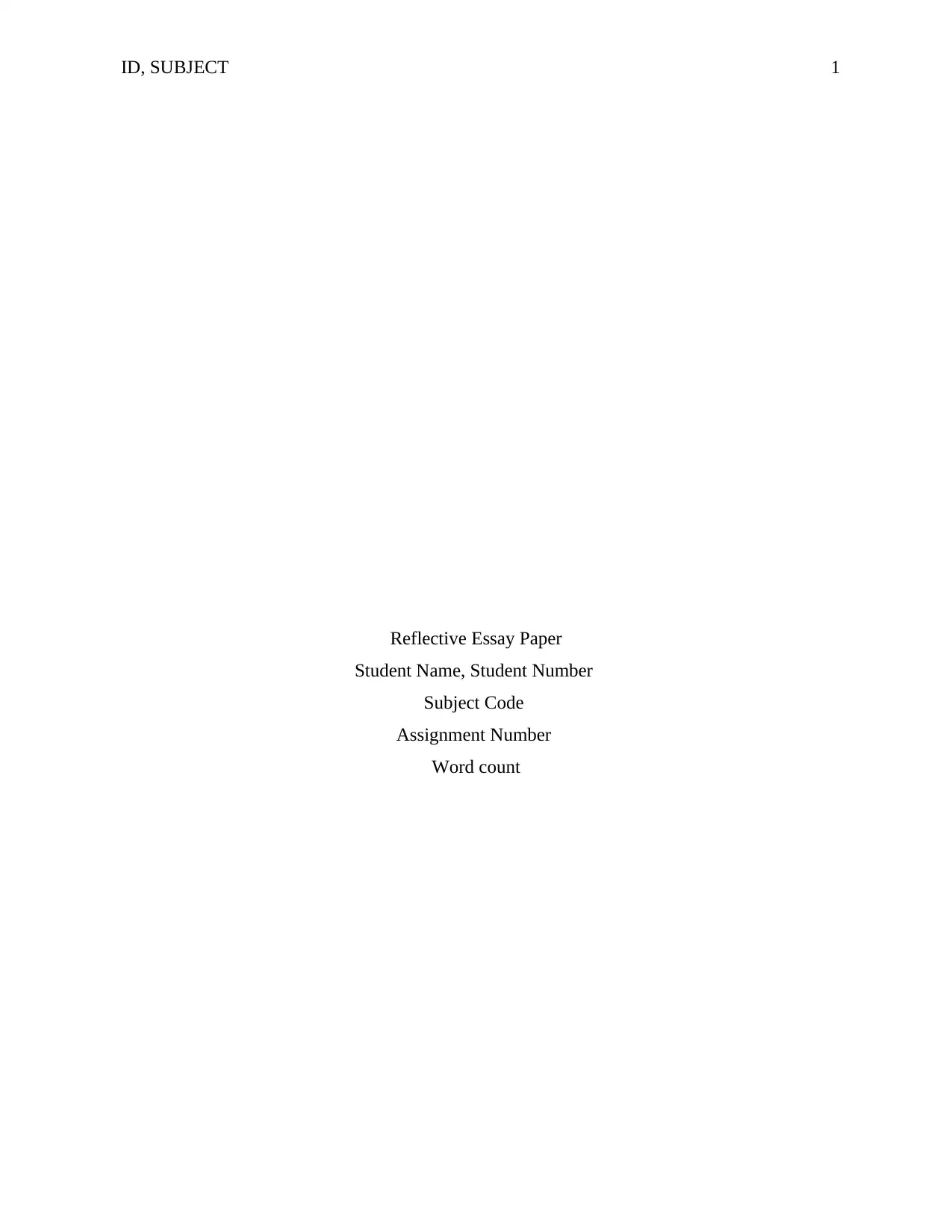
ID, SUBJECT 1
Reflective Essay Paper
Student Name, Student Number
Subject Code
Assignment Number
Word count
Reflective Essay Paper
Student Name, Student Number
Subject Code
Assignment Number
Word count
Paraphrase This Document
Need a fresh take? Get an instant paraphrase of this document with our AI Paraphraser
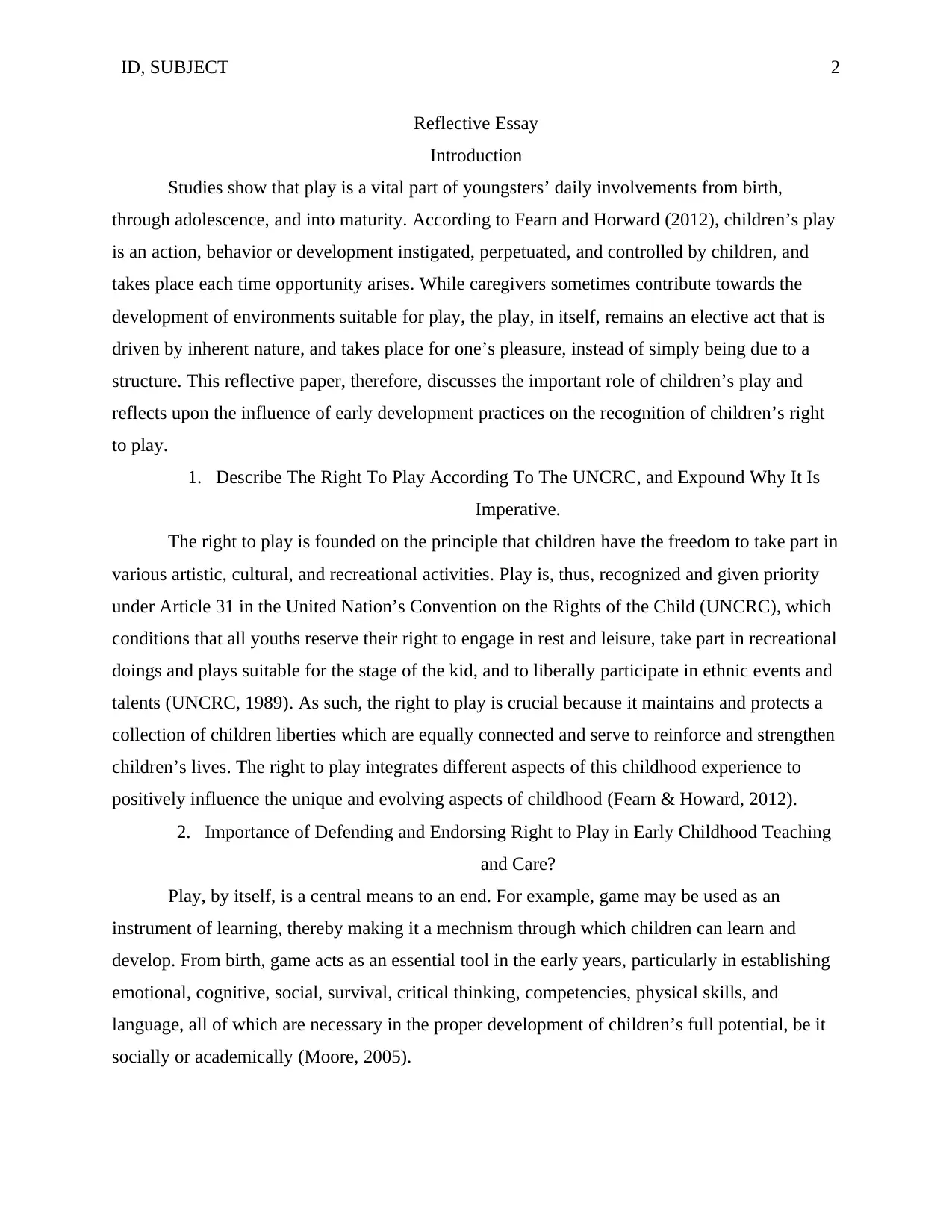
ID, SUBJECT 2
Reflective Essay
Introduction
Studies show that play is a vital part of youngsters’ daily involvements from birth,
through adolescence, and into maturity. According to Fearn and Horward (2012), children’s play
is an action, behavior or development instigated, perpetuated, and controlled by children, and
takes place each time opportunity arises. While caregivers sometimes contribute towards the
development of environments suitable for play, the play, in itself, remains an elective act that is
driven by inherent nature, and takes place for one’s pleasure, instead of simply being due to a
structure. This reflective paper, therefore, discusses the important role of children’s play and
reflects upon the influence of early development practices on the recognition of children’s right
to play.
1. Describe The Right To Play According To The UNCRC, and Expound Why It Is
Imperative.
The right to play is founded on the principle that children have the freedom to take part in
various artistic, cultural, and recreational activities. Play is, thus, recognized and given priority
under Article 31 in the United Nation’s Convention on the Rights of the Child (UNCRC), which
conditions that all youths reserve their right to engage in rest and leisure, take part in recreational
doings and plays suitable for the stage of the kid, and to liberally participate in ethnic events and
talents (UNCRC, 1989). As such, the right to play is crucial because it maintains and protects a
collection of children liberties which are equally connected and serve to reinforce and strengthen
children’s lives. The right to play integrates different aspects of this childhood experience to
positively influence the unique and evolving aspects of childhood (Fearn & Howard, 2012).
2. Importance of Defending and Endorsing Right to Play in Early Childhood Teaching
and Care?
Play, by itself, is a central means to an end. For example, game may be used as an
instrument of learning, thereby making it a mechnism through which children can learn and
develop. From birth, game acts as an essential tool in the early years, particularly in establishing
emotional, cognitive, social, survival, critical thinking, competencies, physical skills, and
language, all of which are necessary in the proper development of children’s full potential, be it
socially or academically (Moore, 2005).
Reflective Essay
Introduction
Studies show that play is a vital part of youngsters’ daily involvements from birth,
through adolescence, and into maturity. According to Fearn and Horward (2012), children’s play
is an action, behavior or development instigated, perpetuated, and controlled by children, and
takes place each time opportunity arises. While caregivers sometimes contribute towards the
development of environments suitable for play, the play, in itself, remains an elective act that is
driven by inherent nature, and takes place for one’s pleasure, instead of simply being due to a
structure. This reflective paper, therefore, discusses the important role of children’s play and
reflects upon the influence of early development practices on the recognition of children’s right
to play.
1. Describe The Right To Play According To The UNCRC, and Expound Why It Is
Imperative.
The right to play is founded on the principle that children have the freedom to take part in
various artistic, cultural, and recreational activities. Play is, thus, recognized and given priority
under Article 31 in the United Nation’s Convention on the Rights of the Child (UNCRC), which
conditions that all youths reserve their right to engage in rest and leisure, take part in recreational
doings and plays suitable for the stage of the kid, and to liberally participate in ethnic events and
talents (UNCRC, 1989). As such, the right to play is crucial because it maintains and protects a
collection of children liberties which are equally connected and serve to reinforce and strengthen
children’s lives. The right to play integrates different aspects of this childhood experience to
positively influence the unique and evolving aspects of childhood (Fearn & Howard, 2012).
2. Importance of Defending and Endorsing Right to Play in Early Childhood Teaching
and Care?
Play, by itself, is a central means to an end. For example, game may be used as an
instrument of learning, thereby making it a mechnism through which children can learn and
develop. From birth, game acts as an essential tool in the early years, particularly in establishing
emotional, cognitive, social, survival, critical thinking, competencies, physical skills, and
language, all of which are necessary in the proper development of children’s full potential, be it
socially or academically (Moore, 2005).
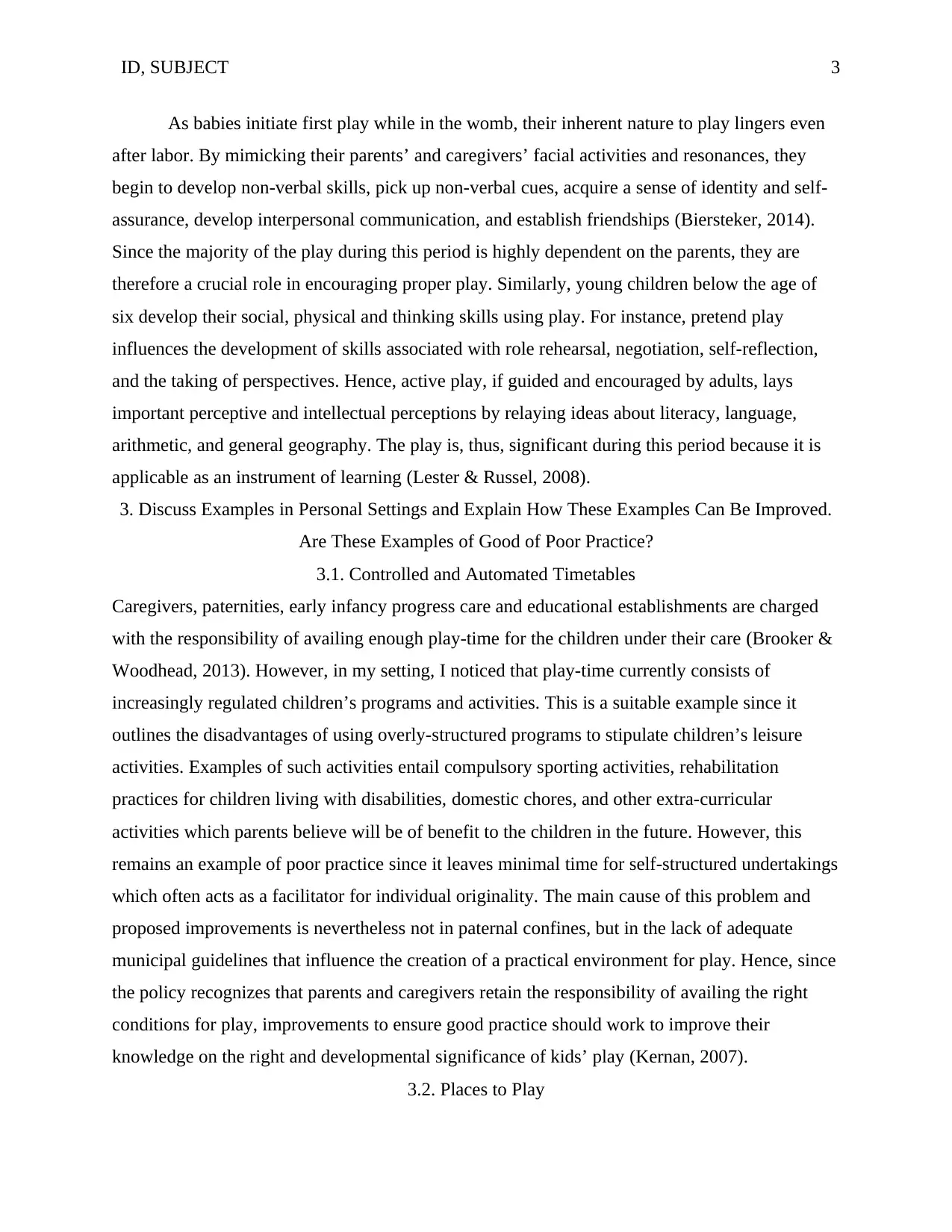
ID, SUBJECT 3
As babies initiate first play while in the womb, their inherent nature to play lingers even
after labor. By mimicking their parents’ and caregivers’ facial activities and resonances, they
begin to develop non-verbal skills, pick up non-verbal cues, acquire a sense of identity and self-
assurance, develop interpersonal communication, and establish friendships (Biersteker, 2014).
Since the majority of the play during this period is highly dependent on the parents, they are
therefore a crucial role in encouraging proper play. Similarly, young children below the age of
six develop their social, physical and thinking skills using play. For instance, pretend play
influences the development of skills associated with role rehearsal, negotiation, self-reflection,
and the taking of perspectives. Hence, active play, if guided and encouraged by adults, lays
important perceptive and intellectual perceptions by relaying ideas about literacy, language,
arithmetic, and general geography. The play is, thus, significant during this period because it is
applicable as an instrument of learning (Lester & Russel, 2008).
3. Discuss Examples in Personal Settings and Explain How These Examples Can Be Improved.
Are These Examples of Good of Poor Practice?
3.1. Controlled and Automated Timetables
Caregivers, paternities, early infancy progress care and educational establishments are charged
with the responsibility of availing enough play-time for the children under their care (Brooker &
Woodhead, 2013). However, in my setting, I noticed that play-time currently consists of
increasingly regulated children’s programs and activities. This is a suitable example since it
outlines the disadvantages of using overly-structured programs to stipulate children’s leisure
activities. Examples of such activities entail compulsory sporting activities, rehabilitation
practices for children living with disabilities, domestic chores, and other extra-curricular
activities which parents believe will be of benefit to the children in the future. However, this
remains an example of poor practice since it leaves minimal time for self-structured undertakings
which often acts as a facilitator for individual originality. The main cause of this problem and
proposed improvements is nevertheless not in paternal confines, but in the lack of adequate
municipal guidelines that influence the creation of a practical environment for play. Hence, since
the policy recognizes that parents and caregivers retain the responsibility of availing the right
conditions for play, improvements to ensure good practice should work to improve their
knowledge on the right and developmental significance of kids’ play (Kernan, 2007).
3.2. Places to Play
As babies initiate first play while in the womb, their inherent nature to play lingers even
after labor. By mimicking their parents’ and caregivers’ facial activities and resonances, they
begin to develop non-verbal skills, pick up non-verbal cues, acquire a sense of identity and self-
assurance, develop interpersonal communication, and establish friendships (Biersteker, 2014).
Since the majority of the play during this period is highly dependent on the parents, they are
therefore a crucial role in encouraging proper play. Similarly, young children below the age of
six develop their social, physical and thinking skills using play. For instance, pretend play
influences the development of skills associated with role rehearsal, negotiation, self-reflection,
and the taking of perspectives. Hence, active play, if guided and encouraged by adults, lays
important perceptive and intellectual perceptions by relaying ideas about literacy, language,
arithmetic, and general geography. The play is, thus, significant during this period because it is
applicable as an instrument of learning (Lester & Russel, 2008).
3. Discuss Examples in Personal Settings and Explain How These Examples Can Be Improved.
Are These Examples of Good of Poor Practice?
3.1. Controlled and Automated Timetables
Caregivers, paternities, early infancy progress care and educational establishments are charged
with the responsibility of availing enough play-time for the children under their care (Brooker &
Woodhead, 2013). However, in my setting, I noticed that play-time currently consists of
increasingly regulated children’s programs and activities. This is a suitable example since it
outlines the disadvantages of using overly-structured programs to stipulate children’s leisure
activities. Examples of such activities entail compulsory sporting activities, rehabilitation
practices for children living with disabilities, domestic chores, and other extra-curricular
activities which parents believe will be of benefit to the children in the future. However, this
remains an example of poor practice since it leaves minimal time for self-structured undertakings
which often acts as a facilitator for individual originality. The main cause of this problem and
proposed improvements is nevertheless not in paternal confines, but in the lack of adequate
municipal guidelines that influence the creation of a practical environment for play. Hence, since
the policy recognizes that parents and caregivers retain the responsibility of availing the right
conditions for play, improvements to ensure good practice should work to improve their
knowledge on the right and developmental significance of kids’ play (Kernan, 2007).
3.2. Places to Play
⊘ This is a preview!⊘
Do you want full access?
Subscribe today to unlock all pages.

Trusted by 1+ million students worldwide
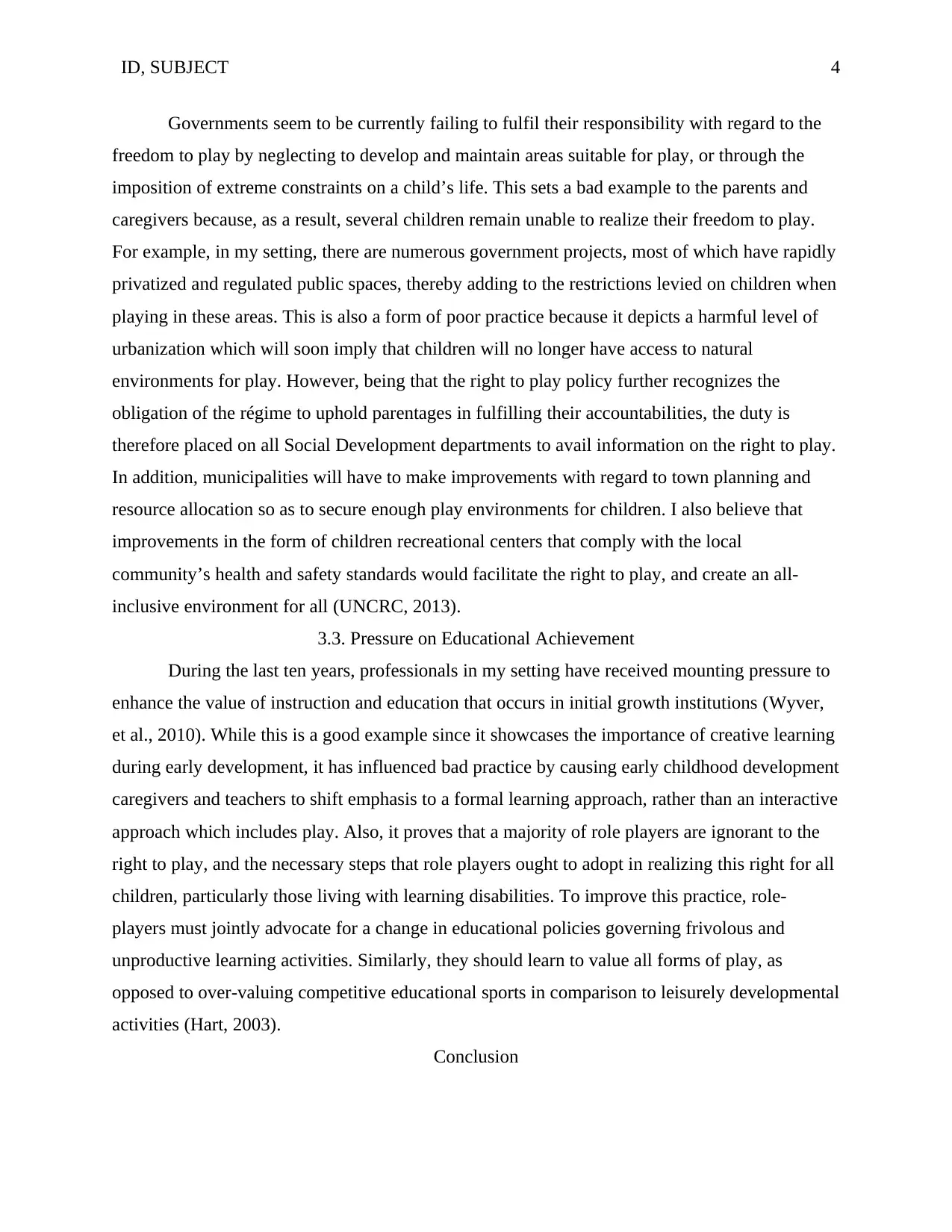
ID, SUBJECT 4
Governments seem to be currently failing to fulfil their responsibility with regard to the
freedom to play by neglecting to develop and maintain areas suitable for play, or through the
imposition of extreme constraints on a child’s life. This sets a bad example to the parents and
caregivers because, as a result, several children remain unable to realize their freedom to play.
For example, in my setting, there are numerous government projects, most of which have rapidly
privatized and regulated public spaces, thereby adding to the restrictions levied on children when
playing in these areas. This is also a form of poor practice because it depicts a harmful level of
urbanization which will soon imply that children will no longer have access to natural
environments for play. However, being that the right to play policy further recognizes the
obligation of the régime to uphold parentages in fulfilling their accountabilities, the duty is
therefore placed on all Social Development departments to avail information on the right to play.
In addition, municipalities will have to make improvements with regard to town planning and
resource allocation so as to secure enough play environments for children. I also believe that
improvements in the form of children recreational centers that comply with the local
community’s health and safety standards would facilitate the right to play, and create an all-
inclusive environment for all (UNCRC, 2013).
3.3. Pressure on Educational Achievement
During the last ten years, professionals in my setting have received mounting pressure to
enhance the value of instruction and education that occurs in initial growth institutions (Wyver,
et al., 2010). While this is a good example since it showcases the importance of creative learning
during early development, it has influenced bad practice by causing early childhood development
caregivers and teachers to shift emphasis to a formal learning approach, rather than an interactive
approach which includes play. Also, it proves that a majority of role players are ignorant to the
right to play, and the necessary steps that role players ought to adopt in realizing this right for all
children, particularly those living with learning disabilities. To improve this practice, role-
players must jointly advocate for a change in educational policies governing frivolous and
unproductive learning activities. Similarly, they should learn to value all forms of play, as
opposed to over-valuing competitive educational sports in comparison to leisurely developmental
activities (Hart, 2003).
Conclusion
Governments seem to be currently failing to fulfil their responsibility with regard to the
freedom to play by neglecting to develop and maintain areas suitable for play, or through the
imposition of extreme constraints on a child’s life. This sets a bad example to the parents and
caregivers because, as a result, several children remain unable to realize their freedom to play.
For example, in my setting, there are numerous government projects, most of which have rapidly
privatized and regulated public spaces, thereby adding to the restrictions levied on children when
playing in these areas. This is also a form of poor practice because it depicts a harmful level of
urbanization which will soon imply that children will no longer have access to natural
environments for play. However, being that the right to play policy further recognizes the
obligation of the régime to uphold parentages in fulfilling their accountabilities, the duty is
therefore placed on all Social Development departments to avail information on the right to play.
In addition, municipalities will have to make improvements with regard to town planning and
resource allocation so as to secure enough play environments for children. I also believe that
improvements in the form of children recreational centers that comply with the local
community’s health and safety standards would facilitate the right to play, and create an all-
inclusive environment for all (UNCRC, 2013).
3.3. Pressure on Educational Achievement
During the last ten years, professionals in my setting have received mounting pressure to
enhance the value of instruction and education that occurs in initial growth institutions (Wyver,
et al., 2010). While this is a good example since it showcases the importance of creative learning
during early development, it has influenced bad practice by causing early childhood development
caregivers and teachers to shift emphasis to a formal learning approach, rather than an interactive
approach which includes play. Also, it proves that a majority of role players are ignorant to the
right to play, and the necessary steps that role players ought to adopt in realizing this right for all
children, particularly those living with learning disabilities. To improve this practice, role-
players must jointly advocate for a change in educational policies governing frivolous and
unproductive learning activities. Similarly, they should learn to value all forms of play, as
opposed to over-valuing competitive educational sports in comparison to leisurely developmental
activities (Hart, 2003).
Conclusion
Paraphrase This Document
Need a fresh take? Get an instant paraphrase of this document with our AI Paraphraser
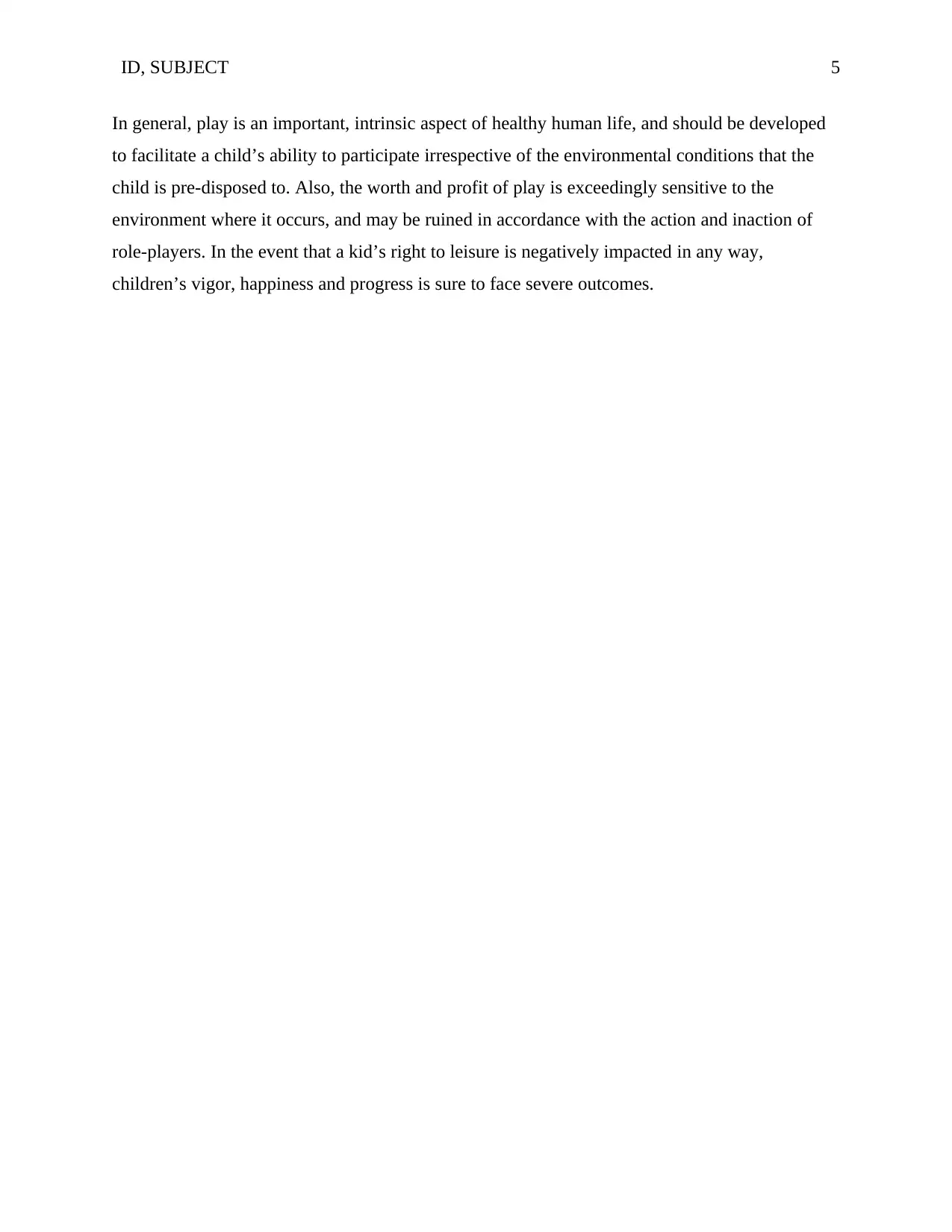
ID, SUBJECT 5
In general, play is an important, intrinsic aspect of healthy human life, and should be developed
to facilitate a child’s ability to participate irrespective of the environmental conditions that the
child is pre-disposed to. Also, the worth and profit of play is exceedingly sensitive to the
environment where it occurs, and may be ruined in accordance with the action and inaction of
role-players. In the event that a kid’s right to leisure is negatively impacted in any way,
children’s vigor, happiness and progress is sure to face severe outcomes.
In general, play is an important, intrinsic aspect of healthy human life, and should be developed
to facilitate a child’s ability to participate irrespective of the environmental conditions that the
child is pre-disposed to. Also, the worth and profit of play is exceedingly sensitive to the
environment where it occurs, and may be ruined in accordance with the action and inaction of
role-players. In the event that a kid’s right to leisure is negatively impacted in any way,
children’s vigor, happiness and progress is sure to face severe outcomes.
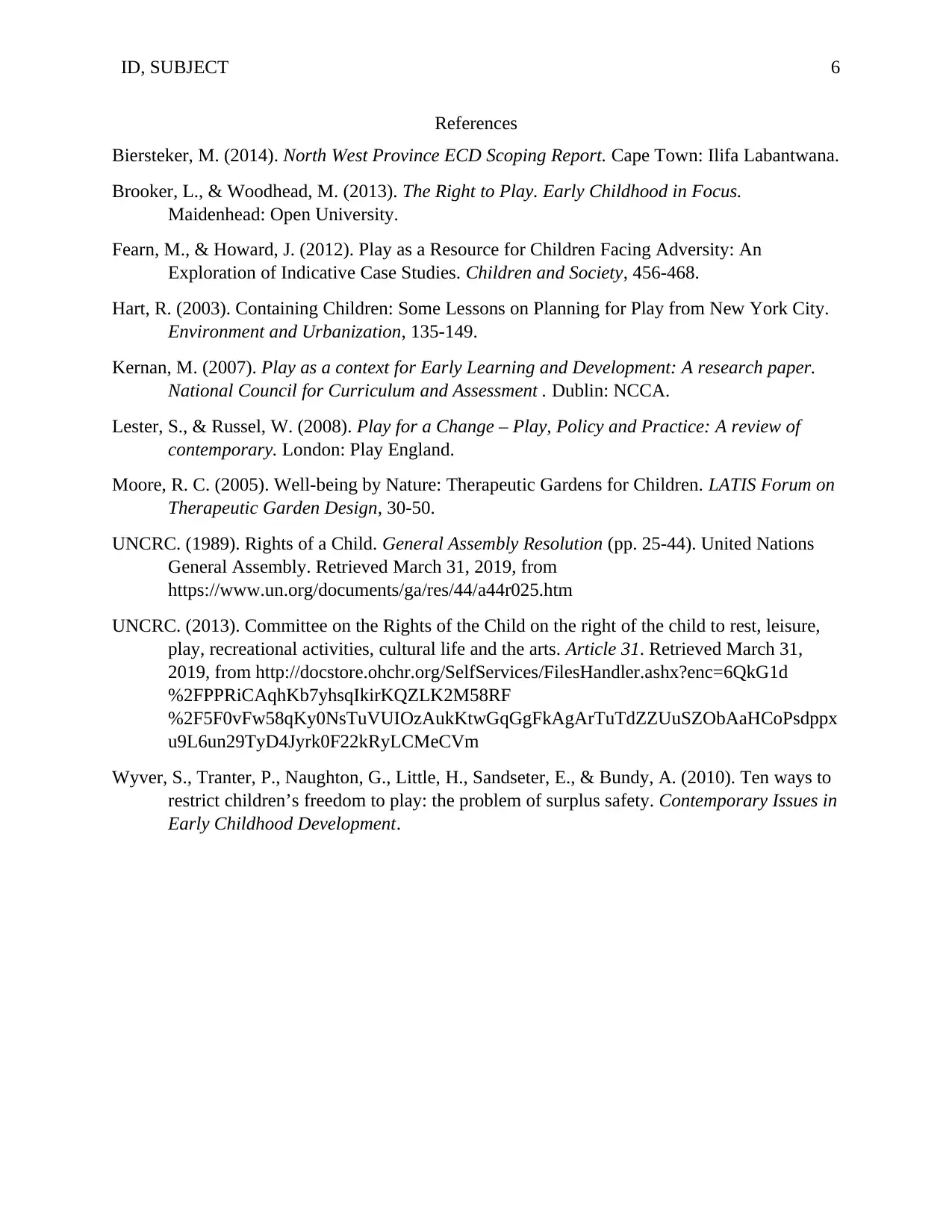
ID, SUBJECT 6
References
Biersteker, M. (2014). North West Province ECD Scoping Report. Cape Town: Ilifa Labantwana.
Brooker, L., & Woodhead, M. (2013). The Right to Play. Early Childhood in Focus.
Maidenhead: Open University.
Fearn, M., & Howard, J. (2012). Play as a Resource for Children Facing Adversity: An
Exploration of Indicative Case Studies. Children and Society, 456-468.
Hart, R. (2003). Containing Children: Some Lessons on Planning for Play from New York City.
Environment and Urbanization, 135-149.
Kernan, M. (2007). Play as a context for Early Learning and Development: A research paper.
National Council for Curriculum and Assessment . Dublin: NCCA.
Lester, S., & Russel, W. (2008). Play for a Change – Play, Policy and Practice: A review of
contemporary. London: Play England.
Moore, R. C. (2005). Well-being by Nature: Therapeutic Gardens for Children. LATIS Forum on
Therapeutic Garden Design, 30-50.
UNCRC. (1989). Rights of a Child. General Assembly Resolution (pp. 25-44). United Nations
General Assembly. Retrieved March 31, 2019, from
https://www.un.org/documents/ga/res/44/a44r025.htm
UNCRC. (2013). Committee on the Rights of the Child on the right of the child to rest, leisure,
play, recreational activities, cultural life and the arts. Article 31. Retrieved March 31,
2019, from http://docstore.ohchr.org/SelfServices/FilesHandler.ashx?enc=6QkG1d
%2FPPRiCAqhKb7yhsqIkirKQZLK2M58RF
%2F5F0vFw58qKy0NsTuVUIOzAukKtwGqGgFkAgArTuTdZZUuSZObAaHCoPsdppx
u9L6un29TyD4Jyrk0F22kRyLCMeCVm
Wyver, S., Tranter, P., Naughton, G., Little, H., Sandseter, E., & Bundy, A. (2010). Ten ways to
restrict children’s freedom to play: the problem of surplus safety. Contemporary Issues in
Early Childhood Development.
References
Biersteker, M. (2014). North West Province ECD Scoping Report. Cape Town: Ilifa Labantwana.
Brooker, L., & Woodhead, M. (2013). The Right to Play. Early Childhood in Focus.
Maidenhead: Open University.
Fearn, M., & Howard, J. (2012). Play as a Resource for Children Facing Adversity: An
Exploration of Indicative Case Studies. Children and Society, 456-468.
Hart, R. (2003). Containing Children: Some Lessons on Planning for Play from New York City.
Environment and Urbanization, 135-149.
Kernan, M. (2007). Play as a context for Early Learning and Development: A research paper.
National Council for Curriculum and Assessment . Dublin: NCCA.
Lester, S., & Russel, W. (2008). Play for a Change – Play, Policy and Practice: A review of
contemporary. London: Play England.
Moore, R. C. (2005). Well-being by Nature: Therapeutic Gardens for Children. LATIS Forum on
Therapeutic Garden Design, 30-50.
UNCRC. (1989). Rights of a Child. General Assembly Resolution (pp. 25-44). United Nations
General Assembly. Retrieved March 31, 2019, from
https://www.un.org/documents/ga/res/44/a44r025.htm
UNCRC. (2013). Committee on the Rights of the Child on the right of the child to rest, leisure,
play, recreational activities, cultural life and the arts. Article 31. Retrieved March 31,
2019, from http://docstore.ohchr.org/SelfServices/FilesHandler.ashx?enc=6QkG1d
%2FPPRiCAqhKb7yhsqIkirKQZLK2M58RF
%2F5F0vFw58qKy0NsTuVUIOzAukKtwGqGgFkAgArTuTdZZUuSZObAaHCoPsdppx
u9L6un29TyD4Jyrk0F22kRyLCMeCVm
Wyver, S., Tranter, P., Naughton, G., Little, H., Sandseter, E., & Bundy, A. (2010). Ten ways to
restrict children’s freedom to play: the problem of surplus safety. Contemporary Issues in
Early Childhood Development.
⊘ This is a preview!⊘
Do you want full access?
Subscribe today to unlock all pages.

Trusted by 1+ million students worldwide
1 out of 6
Related Documents
Your All-in-One AI-Powered Toolkit for Academic Success.
+13062052269
info@desklib.com
Available 24*7 on WhatsApp / Email
![[object Object]](/_next/static/media/star-bottom.7253800d.svg)
Unlock your academic potential
Copyright © 2020–2025 A2Z Services. All Rights Reserved. Developed and managed by ZUCOL.




